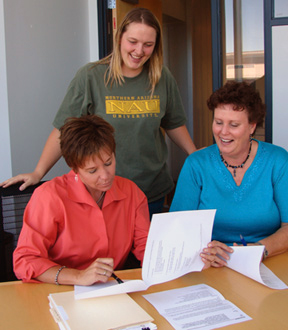When senior environmental engineering major Leslie Ayres steps into the workforce this May, the terrain will be familiar thanks to her real-world experience at Northern Arizona University.
Ayers, along with Michelle Mallett, who recently received a bachelor’s degree in interior design from NAU, designed sustainable shuttle bus shelters for Tusayan, the gateway to the South Rim of the Grand Canyon.
Construction for the shelters is scheduled to begin in the spring.
During 2009 summer internships produced by a partnership with NAU’s Ecological Monitoring and Assessment Program and the Grand Canyon National Park, the students conceptualized a design for environmentally friendly, comfortable, open-air shelters that will showcase the Grand Canyon’s commitment to sustainability.
The student design offers a host of environmental benefits, such as reducing air and light pollution and protecting natural, cultural and historic resources. The design also includes features for a safe and energy-efficient alternative means of transportation, such as shuttles, between the Grand Canyon National Park’s Visitor Center and the community of Tusayan.
“I love the fact that I now have experience with things outside the classroom,” Ayres says. “I can’t wait to go through the area and see the shelters being built or going up there after completion and saying ‘yep, this came from my brain and Michelle’.”
In order to achieve the design benefits, Ayres and Mallett worked closely with the Grand Canyon National Park, the Arizona Department of Transportation, the Americans with Disabilities Act and personnel in charge of local and state building regulations. Susan Thomas, a professor in NAU’s Construction Management Program, and Helen Peterson, a professor of interior design in the College of Arts and Letters, were faculty advisers on the project. Both are accredited professionals in Leadership in Energy and Environmental Design standards.
Ayres and Mallet, both hoping for LEED certification for the shelters, sought to use locally provided materials for the construction while designing a structure that complements existing Grand Canyon National Park architecture.
“The internships with the park allow our students the chance to work with students and people in other disciplines,” Thomas says. “This is how the real world is operating when it comes to sustainable building, so our internships provide experiences similar to the ones students will face upon graduation.”
Ayres and Mallet also had to keep the future in mind when designing their project.
These shelters are anticipated to be integrated into a major Tusayan streetscape upgrade project that will blend the proposed shelters into the future multiuse paths and landscaping upgrades.
“Understanding and interpreting the needs and wants of the client was a challenge. I learned for future projects that understanding needs to be clear before starting major project tasks,” Ayres says. “Another challenge was finding and understanding all of the regulations that go into building a structure.”
Ayres added that the experience has helped her build career goals.
“This project has made me realize that I truly want to be an engineer,” she says. “Now that I know what actually happens, I am excited to be going into the workforce in May.”
Ayres and Mallett’s transit design is being showcased at the Greenbuild conference in Phoenix this week.




